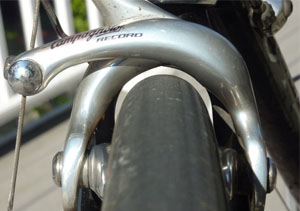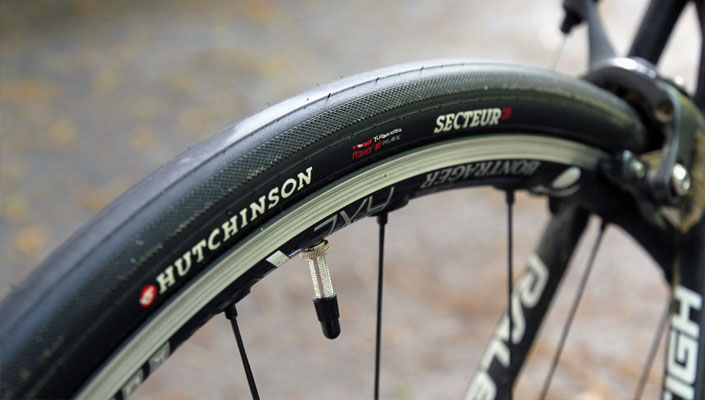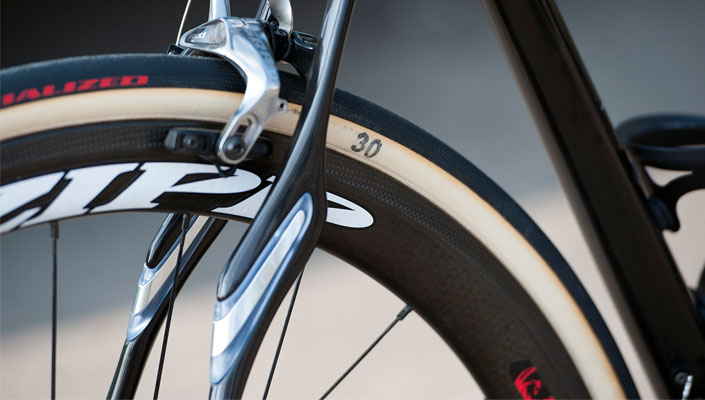Have you ever actually thought about or even bothered to check the width of your road bike tires? Chances are if you bought new tires in the last ten years they would probably have been 23mm and you also most likely were told to keep the pressure around 100 psi.
There have been changing attitudes in the world of road cycling. The emergence of the MAMIL (middle age men in lycra), the growth of the gran fondo scene, and the availability of endurance road bikes designed for the average person who isn't able to fold themselves like human origami, have all been well documented.
But what about tires?
Professional teams have been switching over to wider rubber for a few years now, with 25mm seeming to be the new 23. Many new road bikes, like the Fuji Transonic we recently reviewed, even have frames designed to cater to tires up to 28mm. This was once the sort of dimensions only found on touring or commuting city bikes! So, what is the story and why should everybody be swapping out their hard as a rock 23mm tires to a softer, wider 25 or 28mm?
What are the benefits of wider tires?
Comfort
Yep, the professionals want to be comfortable, too. It makes sense if you are riding 1000km/week that anything which could increase comfort would be looked kindly upon - even more importantly for a weekend warrior who isn't hardened to long hours in the saddle day after day. When you hit middle age, anything that eases saddle comfort is a good thing!
Wider tires have bigger casing (obviously) and the ability to run lower air pressure without the risk of punctures from rim pinches. Greater air volume, more rubber, and a wider, more supple casing increases comfort remarkably, reducing fatigue, saddle soreness, and vibration through the handlebars to your hands.
This is such an important quality as many recreational cyclists are looking to test themselves in century rides and other sportif type events.
Rolling resistance

One reason we have been cautious around adopting a wider tire is the presumption that more rubber means more resistance and therefore slower speeds and harder work for the rider. How many of us squeeze 120psi into narrow 23mm tires before every ride in an effort to extract as much performance as possible? We've become convinced that a tire that feels as hard as solid rubber is the only way to go. I was told by an old school professional cyclist to flick my tires - when it sounded like a metallic 'twang' the pressure was high enough - this was typically at way over 100psi.
It may seem counter intuitive, but in recent tests it was found that bigger volume, wider tires actually have less resistance than their thinner, higher pressure counterparts. This was even true at the lower air pressures which these tires are able to handle. In other words they are faster even with less pressure!
Handling
The mountain biking world has been onto lower-pressure-equals-more-grip-and-control for years now. This came about with the advent of tubeless tire systems and crazy low pressures, but the results spoke for themselves. Massive amounts of grip were made available and the riders just kept getting faster!
NOTE: Tubeless tire systems are already available for road bikes as well. The tire seals to the airtight rim, usually with the assistance of a sealant that heals any breaches or potential punctures. This technology works almost flawlessly on mountain bikes and is worth checking out. The downside is that it requires a specific type of tubeless compatible wheel rim so could be an expensive option.
It is the same for wider road tires. Bigger casing means a larger contact patch. Drop the tire pressure a bit and that contact patch just became even bigger. Lower tire pressure also allows the casing to deform when cornering aggressively - the tire can grip to irregularities and variations in the road surface more effectively, allowing you to lay it down in a corner with less chance of dropping the bike. The direct result is greater confidence when cornering and more control overall.
Aerodynamics
The professionals have been moving towards wider aerodynamic rims anyway, so it seems natural to fit these wheels with wider tires. I don't have any figures to discuss, but the advantages/disadvantages of tire related aerodynamics is probably negligible for the average cyclist.
What do I do?

image: janheine.wordpress.com
If you are riding an older bike, the first step would be to check that you have room in the frame to accommodate wider tires. Swapping from 23 to 25mm shouldn't be too much of an issue, but your best bet is to go to the local bike shop and check it out before ordering. If you want to go wider again to a 28mm beast, then definitely check frame clearance. Some new bikes, particularly the later endurance types, are designed to take very wide tires, but try before you buy.
How much air you put into your new rubber is a personal choice and depends on the tire, rider weight, environmental conditions (like rain!), and riding style. I would recommend following the tire sidewall recommendations, (i.e. don't go above or below the rating) and then play around until you find the best balance of comfort, handling, and importantly, puncture resistance.
Tubeless tires can run down to around 80 psi which is low for a road tire and would typically result in a puncture or pinch flat!
Whatever you choose, upgrading to a wide road tire has enormous benefits. You would be crazy not to!

RELATED ARTICLE:
Training for strength, speed and the sprint
Imagine clicking your lever to change gears only to realize you're in the hardest gear already. You're not sure you can go any faster because last time you checked you were already doing 30 miles per hour... READ MORE




